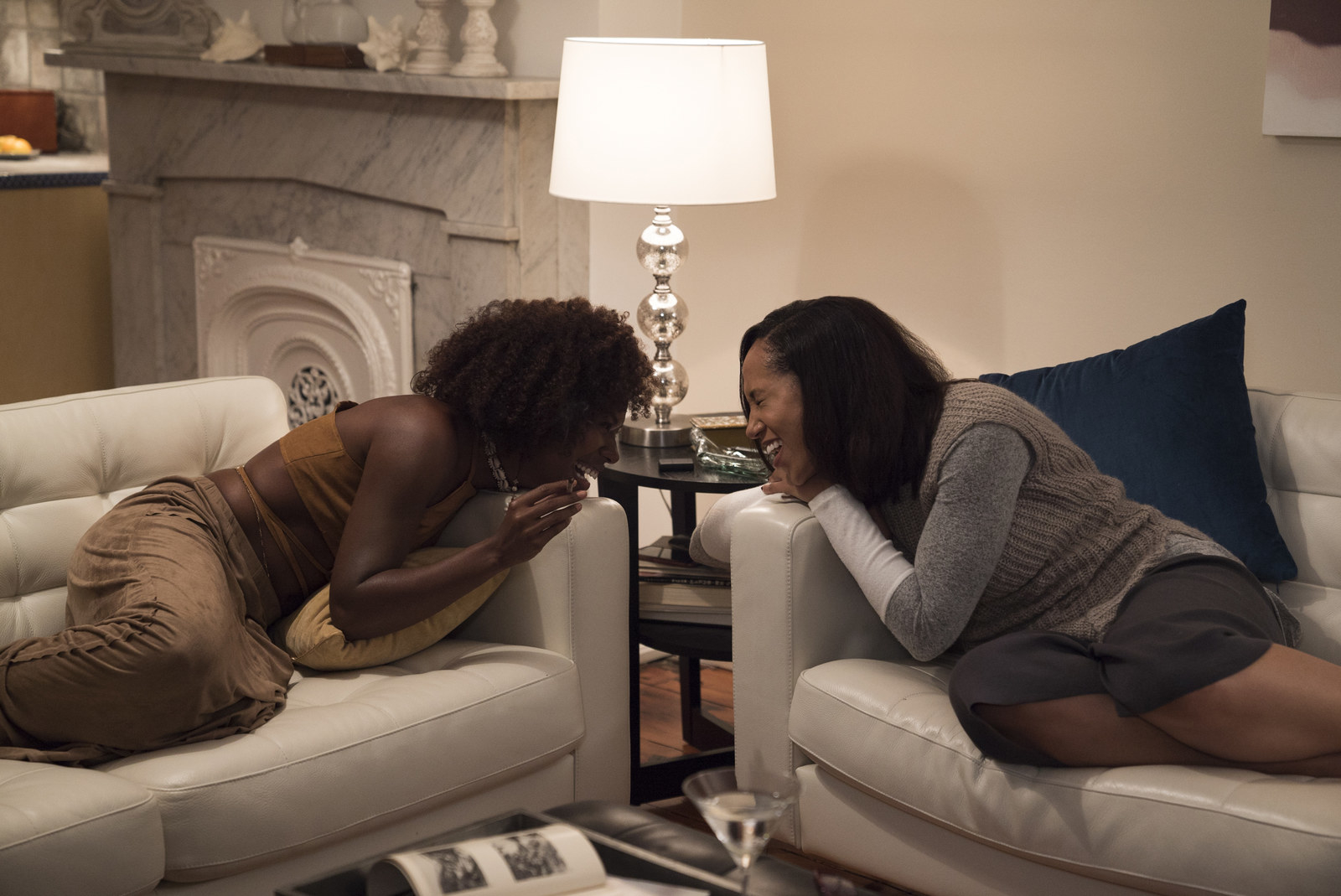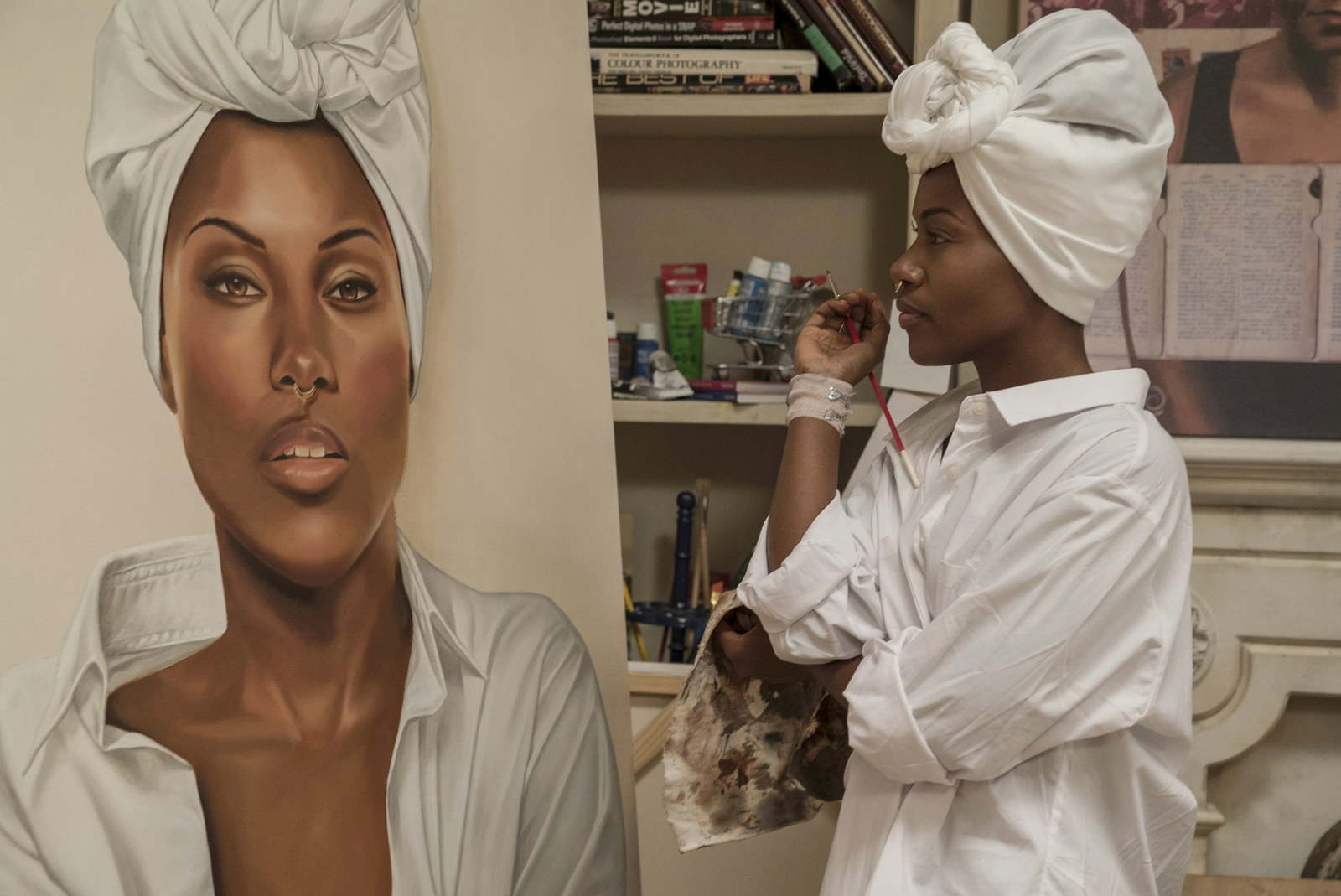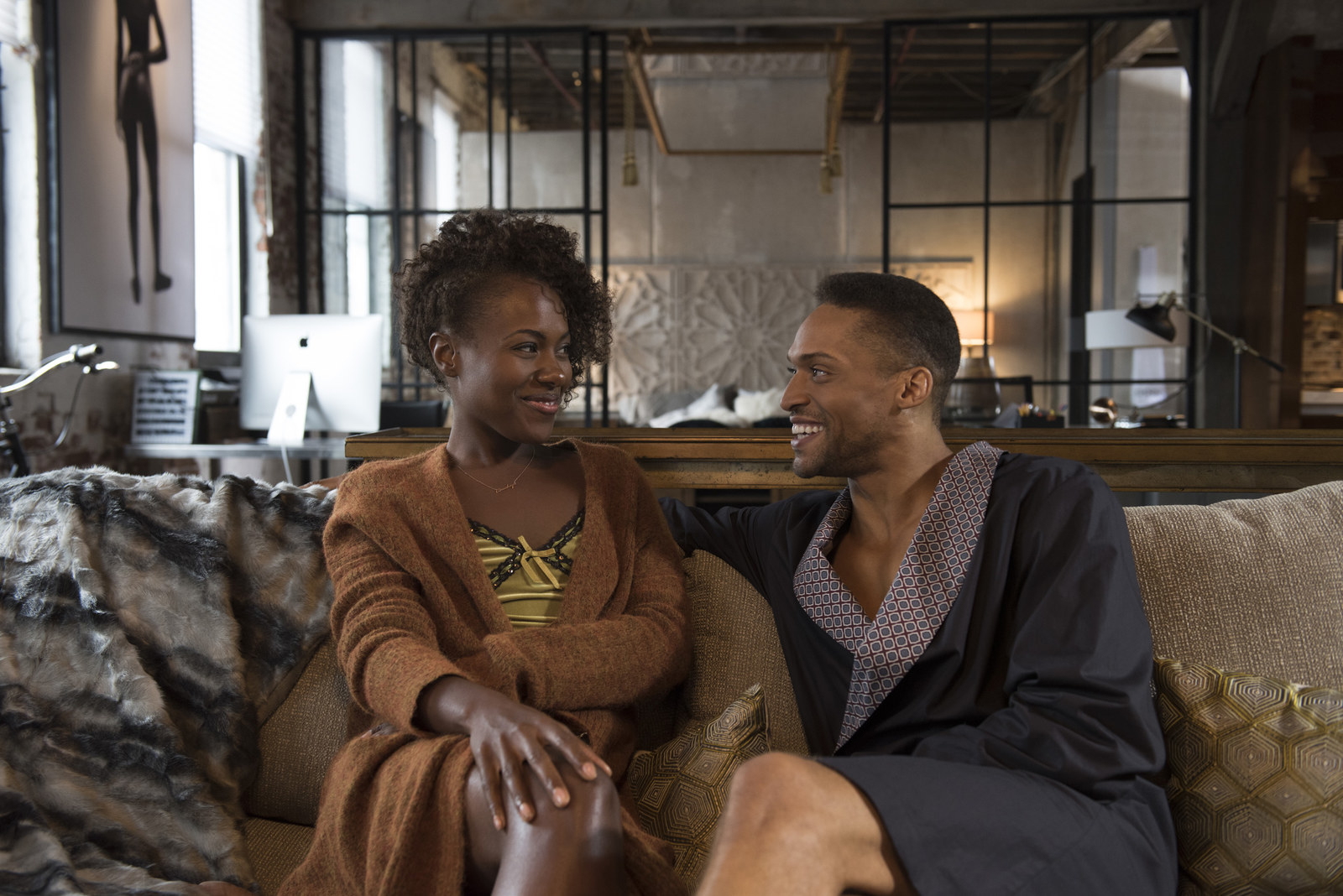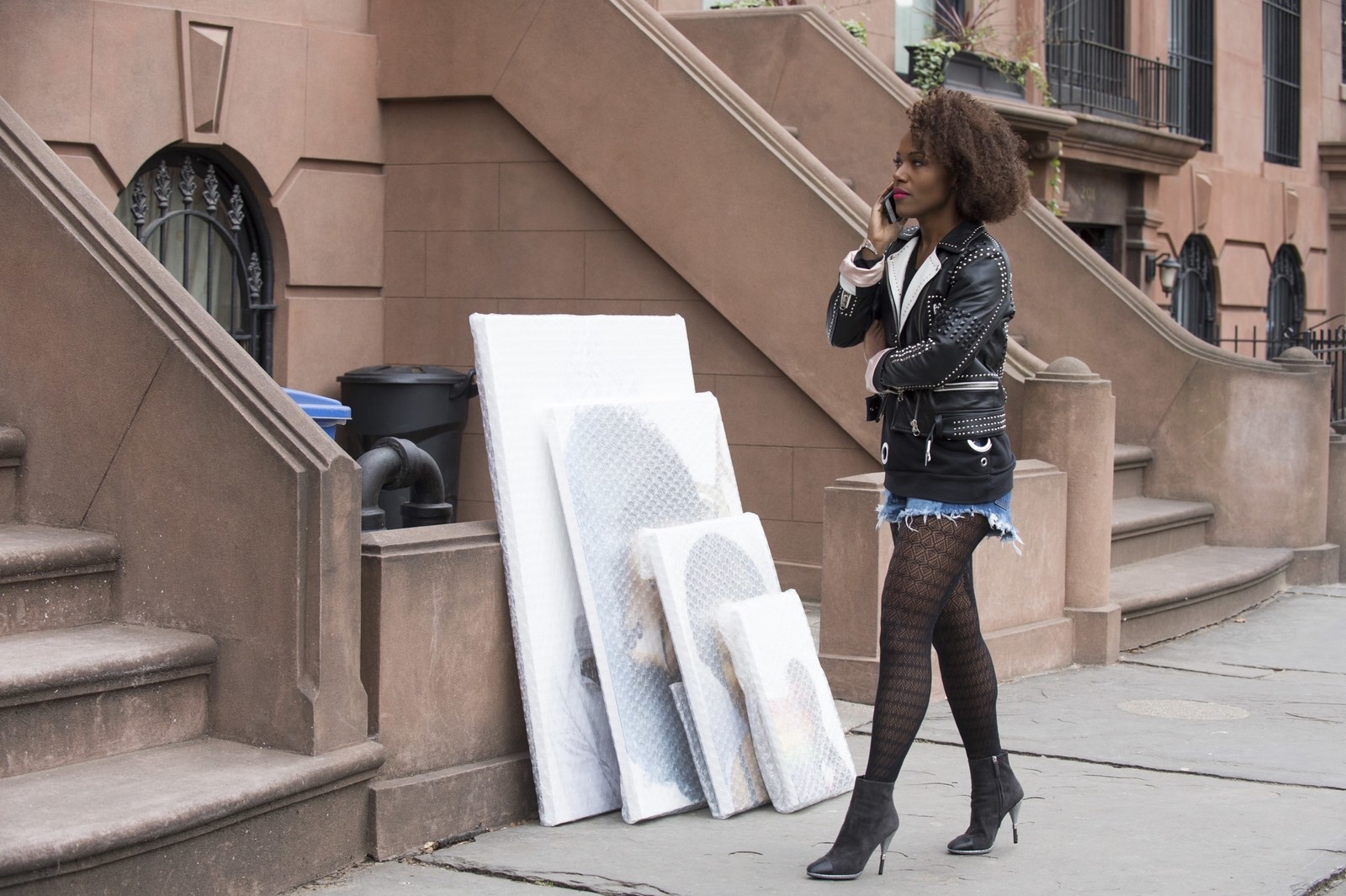
The trailer for the episodic remake of Spike Lee’s first joint, She’s Gotta Have It, starts with the show’s main character, Nola Darling, telling us what she is – a sex-positive, polyamorous pansexual – and ends with her telling us what she is not – a freak, a sex addict, and “damn sure nobody’s property.” But by the end of the new Netflix series you’ll be more inclined to agree with her therapist’s (Heather Headley) description of her: an insatiable young woman who is juggling a lot.
Darling’s character, now a millennial, ties herself to many labels, some of which appear freeing but often put her into a box that can’t contain all that she is. Sometimes her conflicting impulses read as relatable growing pains or loveable flaws, like when she’s late on rent and has to borrow money from her parents. Other times they can read as downright disenchanting, like when she tricks all three of her lovers into dining together at a Thanksgiving meal (more on that later). By the end of the series, it’s unclear whether one ought to love Darling or be annoyed by her, which, ironically is the same dilemma with almost every other character on the show, at one point or another.

The woman who brought these complexities to life, DeWanda Wise, spoke to BuzzFeed News about her beloved Nola Darling. Unlike the characters in the trailer, Wise isn’t as quick to throw a bunch of adjectives Darling’s way. “It's hard for me to describe her because I love her and it's hard for me to describe myself, you know? I'm like any number of great and horrible things at once and I feel like Nola's a number of great and horrible things at once,” said Wise.
One adjective that Wise did agree describes Darling is messy. “It's really fun playing a person who's that messy,” said Wise. “I'm characteristically very type A and orderly. I made a decision before I got married (to fellow Underground actor Alano Miller in 2009) to stop being the heartbreaker that I was. So there's part of me that really identifies with where she's at in her life and how often there's a gap between our ideal self and who we're working towards as a person we are at present is.”
Exploring the gap between Darling’s ideal self and her present self is a salient theme in the show, best depicted in her therapy session scenes with Dr. Jamison, a black woman and Spelman graduate, elegantly played by Headley. Dealing with the trauma from a sexual street harassment incident in Episode 1 spearheads Darling’s decision to seek help, but like many, she soon learns there are other aspects of her life that can and will benefit from therapy.
The sessions are a true highlight of the show because it’s important to see more representations of black folks navigating mental health issues with a licensed professional, but also because seeing a woman work through the trauma that sexual harassment brings on screen couldn’t be more timely.
“I feel like season one is very much about that journey of being like, ‘I'm figuring out who I am,’” said Wise. “But there's all these obstacles and challenges – both internal and external – that stand in the way of her figuring out and asserting and exploring who she is as an artist, as a sexual being, as a friend, as a daughter. So much of her identity is tied up in figuring what that actually is.”

More so than the 1986 movie, the She’s Gotta Have It series gives viewers an in-depth look at a liberated black woman’s evolution. While the original film focused mostly on Darling as a lover and an artist, the series gives audiences an authentic and exhaustive look at her, thanks to a bevy of new characters, the majority of whom are (gasp) black women!
2017’s Darling is part of a cute quartet of girlfriends who refreshingly fall in line with the characters from the 2000’s CW sitcom, Girlfriends. Darling is definitely the Lynn of the group, artistic and free-flowing. Her bestie, Shemekka Epps (Chyna Layne), gives major Maya vibes as she, too, is the only mother of the group and totes an “around the way girl” attitude. (Her butt-implant storyline is also sure to set Black Twitter ablaze.) Then there’s the bad and bougie art gallery curator Clorinda Bradford (Margot Bingham), who, much like Toni Childs, can taste the $3 difference between Grey Goose and house vodka and read you to filth, so don’t try her or her martini. Finally there’s Rachel (Elise Hudson), Darling’s white neighbor who is cool enough to invite to brunch and African dance class, but is rumored to have a thing for black men, so do what you want with that knowledge (I’m not going to call her Joan, the character that introduced us to Tracee Ellis Ross).
"I know her choices are going to incite a lot of conversation in terms of how much in-process she is."
As a friend, Darling is easily the best versions of herself. She’s loving, non-judgmental, empowering, and vulnerable with her girls in a way we never see with the men on the show. But because she’s Nola, there’s always a dash of mess somewhere. In this part of her life, it’s the fact that one of her lovers, Mars Blackmon (Anthony Ramos), is the ex-boyfriend of her friend, Bradford (a red flag in the unofficial girlfriend’s handbook, especially since Bradford seems only half-OK with it) — making Darling not exactly the good girlfriend I want her to be.
Then there is the awesome group of black women who guide and mentor Darling along her journey: her boss Raqueletta Moss (De'Adre Aziza), her godmother/landlord (Pauletta Washington), and of course, Dr. Jamison. All black, all accomplished in one way or another, and all quick to check Darling when she’s tripping especially hard, which happens often.
“I know her choices are going to incite a lot of conversation and I'm interested to see what else everyone else like picks up on, in terms of how much in-process she is. It was that thing where I could definitely look back and be like, ‘Oh, man. I remember being in my own way in the way that Nola was,’” said Wise, whose last name became pleasantly accurate during our conversation.

We also get to meet Darling’s parents for the first time. They’re lifelong residents of Fort Greene, Brooklyn (who aren’t selling their brownstone, no matter how much you’re offering), and are just as artistic and outspoken as their daughter. They’re also married, which puts a deliciously sharp dagger in the misogynistic narrative that only women with “daddy issues” are sexually hyperactive.
Darling’s trio of male lovers, Blackmon, Greer Childs (Cleo Anthony), and Jamie Overstreet (Lyriq Bent), and her sole woman lover, Opal Gilstrap (Ilfenesh Hadera), are the aspect of the series that is most true to the film. Darling’s sexual liberation remains one of the most revolutionary things about her character and the project. The girl makes Issa Rae’s hoetation on Insecure look like child’s play, because while Issa could barely get the three men she dated after her breakup with Lawrence to be available, when Darling says jump, her three men ask how high.
Just as it was in 1986, and every year in between, it’s always fun to see a woman treat men the way we often only get to see a man treat women both in real life and on the screen. “There's definitely that thing where there's like this sense of like, ‘I'ma win this. It's a competition,” Wise said of Darling’s rotation. “They're situating and framing Nola as a woman worthy of these three fine brothers and I think that alone is a powerful statement.”
A single black woman in New York City refusing to commit to not one, but three men, and a woman, all of whom clearly adore her, is quite a bold statement. Especially with the “black women can’t find a man” narrative that continues to bombard black women at every turn both on screen and in real life, especially in cities like New York (it’s hard out here)! But you won’t find such notions in Darling’s loving bed. No matter how hard all of them want to be her one and only, she refuses to be “possessed” by any of them. And while clear dashes of commitment issues are sprinkled in with Darling’s polyamorous ways, healthy relationships/marriage do not make partners each other’s possessions. The constant sexual expression shot with the female and male gaze in mind (Wise says we can thank Tonya Lewis Lee for that) is without a doubt the show’s naughty nucleus. No Netflix original (or most shows on cable) has ever contained this much black sex. Think Samantha’s sex scenes from Sex and the City with all black bodies but no full frontal shots from Wise — because that’s where she and her hubby decided to draw the line — but plenty of black male nudity à la Power and Insecure.

But true to her character, enjoyment of the portrayal of her sexual liberation is interrupted by a few striking facts. First of all, Overstreet is still married. And while he and his wife Cheryl Overstreet (Sydney Morton) — aka cut from the talented tenth cloth, born with a silver spoon in her mouth — sleep in separate rooms, they’re still together enough for her to be pissed when she finds out about her husband and Darling. And while I can’t speak for everyone, one of her lovers being a married man definitely drains some of the fun out of it for me, the same way it did during every Olivia and Fitz love scene on ABC’s Scandal.
There’s also Darling’s sometimes callous treatment of the men in her life to consider. As the new adage goes, men are often trash, and certainly, Darling’s trio are no angels, but her transparency as a liberated sexual woman is often mixed with a bit of cruelty and manipulation under the guise of being forthcoming. For example, in the show’s season finale, Darling invites all three of her male lovers to have Thanksgiving dinner together. And while she labels this an act of transparency, she was quite the opposite when she invited each of them without divulging that the other two were invited as well. Like, I’m all for a roster, but do you have to force your roster to sit down and break bread together, and on a holiday, too? Each man is clearly aware that the others exist, but should the passive acceptance of that be read as: yes let’s be one happy polyamorous family? It almost felt like a flipped version of a VH1 Love & Hip Hop reunion.
The whipped cream on the sweet potato pie during that Thanksgiving dinner was a painting of all three of them by Darling. It depicted them bound at their hips, and completely naked with their dicks painted true to size. If they weren’t feeling insecure enough before, they could now all compare their dick sizes to each other's, together, while Darling stands, smiling. It was messy.
"Give the Nolas in your life a little grace, and compassion, and help them get there."
Though open to that interpretation, Wise disagrees. “The Thanksgiving scene, for me, was indicative of like, can we all like coexist? ‘Now, you know each other exists, you see each other face-to-face. I'm not saying this is how we need to live our lives and that we need to have family dinner every night. But like this is the situation, you know?’ So yeah, I totally took her side and was just like, ‘Look at Nola being transparent, and growing up, and getting her life organized,’” she said.
That’s the thing about Darling. She’s a lot like her art — beautiful, black AF, and open to interpretation. And just like art, she’s worthy of your time and observation, but doesn’t exist to please all. But perhaps, most important, she demonstrates almost perfectly what it means to be young and figuring it out, and that stage of life is seldom stain free and clear cut.
Wise, too, cautions this in trying to interpret Nola. “The things that frustrate you the most are ordinarily something you've worked through or overcome in your life. So when you see it in someone else’s you're just like, ‘Hey get here. It's so much better on this side when you’ve moved through that shit.’ So I would just say, give the Nolas in your life a little grace, and compassion, and help them get there. Because I do believe that she will,” she said.

In watching Darling, however, it’s easy to try to project onto her character who you want her to be. Long gone are the days when perfect Clair Huxtable characters are sustainable, and arguably, viewers don’t want characters whose perfections make them impossible to relate to. There’s also a proclivity to hold black shows to a higher standard than others, which partially stems from a lack of representation in the media. It feeds the notion that representation of black women in the media should be limited only to characters that can be relatively or absolutely “good,” instead of characters that contain multitudes. It’s why, initially, black viewers lamented that the first black female lead character on network television in decades — Scandal’s Olivia Pope — also happened to be the show’s white president’s mistress. It’s why everyone all of a sudden wanted a safe sex lesson from HBO’s Insecure. It’s why we were up in arms when (Queen Sugar SPOILER ALERT) Blue turned out not to be Ralph Angel’s real son.
"There are too many women, who haven’t seen their journey portrayed on TV."
“We know these things and people exist in the black community, we just don’t want everyone else to know,” said Wise.
Nola Darling, however, is not a one-dimensional character; she is not flawless, and at times, she is completely disagreeable. But she’s also a good friend (most of the time), an artist determined not to let the world silence her creative point of view, and a woman who demonstrates what living life on your own terms can look like. She has depth and strengths, faults and hangups. And because of this, viewers will find her immensely important to the representation of black women as complex beings on television in 2017. We need to see more Nola Darlings, not despite their imperfections, but because of them.
Wise agrees. “I've never been interested in being like, ‘I just wanna play characters that were written for white people. And then it's just me.’ No, no, no, no, no. I want to cover the gamut and the range of what it means to be a woman who looks like me,” Wise said, adding, “That’s how I see my job and my position in this industry. And I'm trying to like keep the blinders on from the criticism a little bit so that I can continue to do that. Because there are too many girls out there, too many women, who haven’t seen their journey portrayed on TV.”
